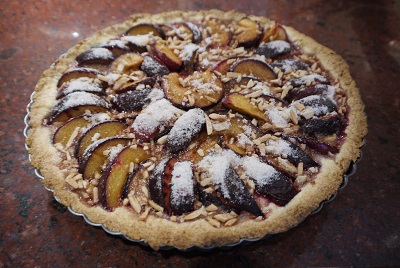I originally wrote this piece for Combined Jewish Philanthropies to help get word out about their Fast to Feed initiative. A number of people contacted me offline for the plum cake recipe, so I’ve decided to also share the post and the recipe here.
Recently, Prism asked me to teach a class on how to bake plum cake for Rosh Hashanah. So what qualifies me as a plum cake expert? I guess I have to credit my Mom’s family. They are German – yekkes, as they would proudly say – and my Oma would always bake a zwetschgenkuchen (or some say pflaumenkuchen), a traditional plum cake, for the holiday. Someone recently asked me about the looming symbolism of the plum for Rosh Hashana, hoping to find some sort of sweet correlation as with the apples and honey. Well, to be honest, as far as I know, late August and early September was when the Italian plums were ripe and hung heavy on the trees of the German and Alsatian countryside. So plum cake for Rosh Hashana made sense. And was always delicious.
A few years back I made a zwetschgenkuchen to bring to my mom’s for the holiday. I used the pitch-perfect plum torte recipe from the New York Times archives. The plums were wrapped in soft pillows of batter, and topped with cinnamon, lemon and sugar. Just splendid. But when Prism asked me to lead the plum cake baking class, my mom jumped at the chance to share a genuine kuchen recipe with me.
It turns out my Oma, along with millions of other Germans Jews before her, based not just their plum cakes, but their general baked goods, on a mürberteig, a “shortcrust dough.” This morning I took the recipe for a test run, cutting the butter into the flour, making pebbles of dough that eventually formed a ball to kneed and roll out.
We hosted friends for the taste testing that afternoon. As it happens, they are Mormon and, as strange as it sounds, we actually understand the choices we’ve each made through our respective religious outlooks. My not eating pig and shellfish is similar to their choice of not drinking alcohol or coffee.
When I told them about Combined Jewish Philanthropies’ Fast to Feed program, they got it. As I explained, Jews observing Yom Kippur abstain from eating and drinking. Why not take the money you’d be spending on food during that day, and donate it to a program that feeds one of the 700,000 people that go hungry every day? Well, it turns out that Mormons have a fast on the first Sunday of every month, and the money they’d be spending on food is donated to feed the hungry. No kidding.
The plum cake was fantastic, and I’m thrilled to be teaching my family’s tradition on Thursday night.
Zwetschgenkuchen: Traditional German Plum Cake
This sweet dessert starts with a Murberteig, a mellow or short dough, which is the basis of many German baked goods. Simply, it’s a shortbread dough.
For this recipe, you will need a pastry cutter, a large bowl, a rolling pin, a dough scraper, and a tart pan.
Ingredients
2 cups flour
1 teaspoon baking powder
½ cup sugar
Pinch of salt
¼ lb. butter
1 egg, beaten
Directions
Cube the butter and place in freezer while you gather and measure out the remaining ingredients.
In a large bowl, combine the flour, baking powder, sugar and salt. Mix them together with a whisk or a large spoon.
Sprinkle the chilled butter cubes over the flour and begin working them in with the pastry blender, using it to scoop and redistribute the mixture as needed so all parts are worked evenly. Soon enough, all of the butter pieces will be the size of tiny peas.
Make a well in the center of the bowl. Add the beaten egg and using a spatula, mix thoroughly. Soon enough, the dough will come together. Knead the dough on a breadboard/hard counter.
This dough has a very high butter content, so refrigerate it while you prep the rest of the ingredients.
Plum topping
2 lbs. of plums
¾ cups sugar
1 teaspoon cinnamon
½ cup chopped almonds
Halve and pit the plums. Slice the fruit into quarters. Set fruit aside.
Chop the nuts. Place in bowl with the sugar and cinnamon. Stir.
Remove the chilled dough from the refrigerator. Flour your counter, the dough in the middle and the rolling pin. Start rolling your dough lightly from the center out. You’re not going to get it all flat in one roll or even twenty; be patient and it will crack less. Roll it a few times in one direction, lift it up and rotate it a quarter-turn and repeat. Re-flour the counter and the top of the dough as needed to avoid sticking.
Roll the dough out to a little more diameter of your tart pan, enough to cover the entire the inner sides of the pan. Using the dough scraper, gently move the rolled-out dough onto and press into the pan. Don’t worry if you get a crack or hole; just use some of the excess from the edges to patch it up!
Starting with the outer rim, arrange the sliced plums in a circle on dough.
Evenly sprinkle the sugar and cinnamon and nuts on top of the plums
Bake in a preheated, 375-degree oven for 30 minutes.


